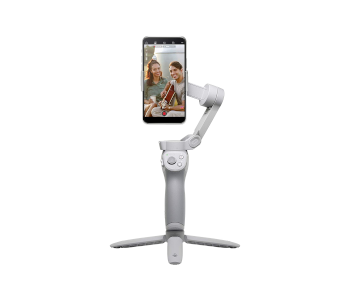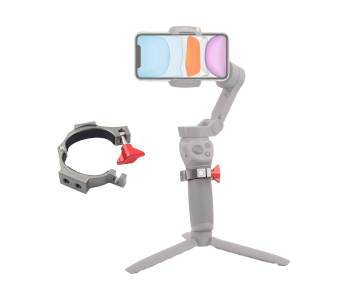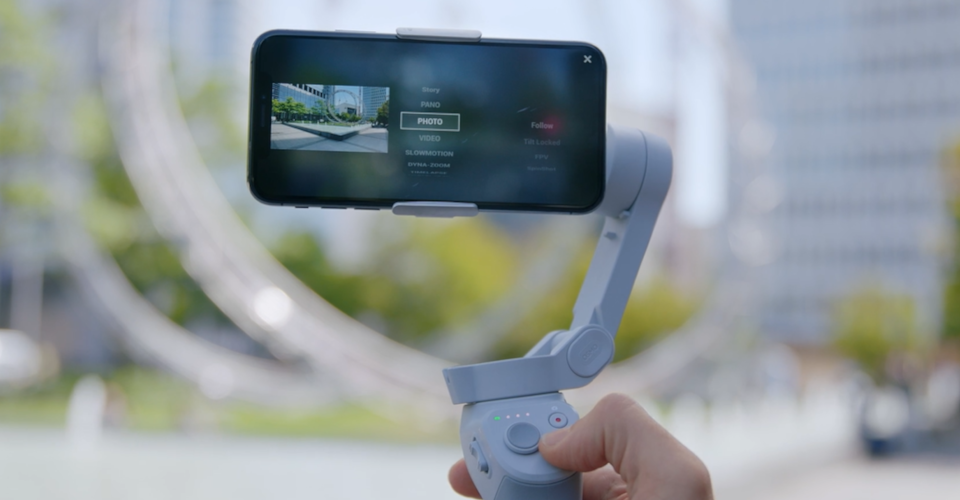DJI OM 4 Review – Is It Worth It In 2020?
Today’s camera phones can pretty much go toe-to-toe with professional cameras from the previous generation, all in one convenient package. This has paved the way for both amateur and professional vloggers who can document their daily lives with ease.
If you’ve ever taken a video while walking around, then you’ll know that the video will end up shaky even with electronic stabilization features. To get buttery smooth videos, you will need to shoot with a gimbal. This is the problem that DJI is seeking to solve with the OM 4.
Overview
As its name implies, the OM 4 is the 4th iteration of DJI’s Osmo Mobile series – a line of handheld gimbals designed to be used with camera phones. This comes less than a year after the previous entry, the Osmo Mobile 3. As with the previous versions, the DJI Mimo app extends the capabilities of the Osmo Mobile 3 with smart features and more refined control options.
This fourth stab in the technology has resulted in a product that is better-designed, smarter, and surprisingly well-priced compared to the previous versions. With a user-friendly interface and functions made for easy social media sharing, the OM 4 might just be the device that propels handheld gimbals into mainstream popularity.
Build quality, design, and portability

Weighing in at less than 400 grams, the OM 4 is a remarkably compact and portable handheld gimbal. Compared to the design of previous generation Osmo Mobile gimbals, DJI has made several but notable changes to this entry. The most striking is the use of a magnetic mount and two-tone off-white and light gray color scheme which gives this gimbal a more accessible and less intimidating look – which might be the exact image that DJI was aiming for.
The use of a magnetic mount is on the most prominent changes that DJI made with the design of the OM4. It is essentially made of two pieces – a magnet attached to the gimbal and a second piece of magnet that attaches to the phone. The phone magnet also doubles as a finger-ring. The use of a magnetic mount makes it easier than ever to attach and detach a phone to the gimbal and eliminates the need to do auto-calibration every time.
The prospect of a magnet to secure your phone to the gimbal may seem like a scary idea, but we’re happy to report that the magnet holds up well even on larger and heavier phones like the Samsung Galaxy Note 20.
The single-piece construction of OM 4 makes it less fiddly and easier to pack into the folded orientation. Folding requires only a single joint. It retains the side-folding orientation of the gimbal arm, which certainly helps in making the OM 4 much more compact when folded, which is only slightly larger than the size of your palm.
The side-oriented arm bucks the trend of older handheld gimbals, which typically had the gimbal arm towards the back of the mobile device. The design is not instantly intuitive, but we appreciate how this innovation has made this gimbal so much more compact. The construction is light enough to be comfortable for prolonged one-handed use but does not feel cheap or less than premium.
When deployed, the grip is oriented at a comfortable 15 degrees and provides access to a trigger button, two face buttons, a joystick, and a slider. The grip design allows for fully one-handed use unless you need to activate the modes that are only accessible via the DJI Mimo mobile app.
The base of the ergonomically shaped grip has a threaded hole designed to connect with a tripod.
Although the Osmo Mobile 3 was already a pretty powerful gimbal for its size, it still ended up struggling with larger phones. DJI addressed this in the OM4 by using more powerful motors which better handles heat during use. It also gives the OM4 a wider range – around 10% further in both the vertical and horizontal directions.
All in all, DJI has made a crucial design change to the OM4 by using a magnetic mount. Aside from that and the change in color scheme, the OM4 looks very similar to the Osmo Mobile 3. Although the changes may have compromised on minor areas, the result is still a huge net positive.
Interface
As with the older models, the OM 4 has been designed to be used with just one hand. This means that all its essential controls are easily accessible on the grip and can be accessed with just your thumb and forefinger.
The trigger button is back with the OM 4. This provides a quick way to re-center the gimbal, lock its position, switch between the phone’s rear and front cameras, and to quickly activate Sport Mode. Under Sport Mode, the panning speed of the gimbal is set at the maximum to allow for tracking of fast-moving subjects.
The user-facing side of the gimbal has two other buttons and a joystick for moving the gimbal around. At the top of this button panel is an LED indicator for the battery level. The M button is one of the most useful in the gimbal, allowing you to quickly switch between portrait and landscape orientations with just a double-tap. A triple-tap of the M button swaps the gimbal between its starting and stowed positions. Zooming can be done using the slider panel located at the side of the grip.
Although the more advanced functions can only be accessed via the DJI Mimo app, you will probably end up spending most of the time using the Osmo Mobile 3 one-handed.
Software
The DJI Mimo app acts as the software partner of the OM 4 and needs to be installed in a smartphone that has been paired by Bluetooth with the gimbal. The app is available for both Apple and Android platforms and gives access to more advanced video options like ActiveTrack 3.0, HyperLapse, and MotionLapse.
ActiveTrack 3.0, the same subject tracking feature found in modern DJI drones, will probably turn out as the favorite of most people. This allows you to draw a rectangle around a subject to command the gimbal to follow it around as it moves. It’s not foolproof, especially when these subjects move around too quickly. After all, this is mostly due to limitations in the movement speed of the gimbal, but you can always help it out by moving the entire gimbal around. The tracking feature also works on faces should you want to capture selfie-style videos.
HyperLapse and MotionLapse are two of DJI’s variations on time-lapse filmmaking. MotionLapse captures a time-lapse video with motion, while HyperLapse allows for the simultaneous movement of both the camera and the gimbal. Through the app, you can also choose certain points in your time-lapse to “slow down” to create dramatic moments. Of course, shooting standard time-lapse videos is still an option.
The app has a 3x 3 Pano mode which stitches together overlapping nine static photos – just like the Panorama mode of any other camera. The advantage of 3×3 Pano with a gimbal is that it creates a super-wide shot that is much smoother and requires no complex post-processing. You can also take a more traditional Panoramic shot which maximizes the 240-degree range of the OM4.
If you’re on your own, you can simply mount the OM 4 on a tripod and utilize the gimbal’s gesture control feature. Simply step to the front of the camera, make a peace sign, and the camera will automatically track you and have the gimbal follow you around.
The Dynamic Zoom mode is a new introduction to the OM4. More commonly known as the “Vertigo effect,” this is a cinematic technique that shifts focus on the subject while the camera moves away. The result is a somewhat disorienting but impressive shot that is very hard to pull off manually.
While professional filmmakers will likely take the footage they have shot and post-process it with software, DJI Mimo offers a Story feature if you just want to make a short clip for quick sharing in social media. Story mode creates a montage of the photos and videos that you captured and sets it to music. It’s nothing too fancy but is nice for giving your followers an update while you work on something more refined.
Spin Shot is a quick move that spins the phone around. Although this would be nice for creating transitions between clips, we find that the execution of the move is spotty at best.
Despite how good the app seems, it is actually the part of the OM 4 experience that could use the most improvement. In terms of quality, videos shot through the DJI Mimo app seem inferior to those shot in the native camera apps, especially for excellent camera phones like iPhones. This is especially pronounced when shooting in harsh lighting, as videos tend to look washed out or overexposed. Hopefully, this is something that DJI can address with an app update.
Only the Apple version of the DJI Mimo app allows for recording at 60 fps, as well as in Slow Motion. This is probably due to hardware limitations more common with Android phones, but we are also hoping that DJI can add an option in the app for Android phones that are capable.
Battery
The OM 4 comes with a 2450 mAh battery that allows for about 15 hours of use. The gimbal comes with a USB-C port that supports fast charging. The battery lasts long enough for a whole day of shooting and can be charged from empty to full in a little over two hours.
A nice feature of the OM 4 is the full-sized USB port that allows for charging of external devices using the battery of the gimbal. This is an excellent backup power source for your phone, as shooting hours of videos will inevitably be taxing on a phone battery.
As far as battery specs and features go, the OM4 is essentially identical to the Osmo Mobile 3. The use of more powerful motors in the OM4 means that it does not run as hot as the Osmo Mobile 3, which should help the battery last a little longer.
Accessories

By default, the OM4 comes with several pre-included accessories – a pouch, wrist strap, tripod, the magnetic clamp, and a magnetic ring holder. The product hasn’t been in the market for much longer than a month, so the selection of third-party accessories is still pretty small. However, you should be able to grab good carrying cases or hot-shoe adapters for the OM4.
Price
The OM4 bucked the trend of DJI undercutting the prices of their previous generation Osmo Mobile gimbals. The OM4 is only available as a bundle that costs $149. For comparison, the Osmo Mobile 3 was launched at $119 standalone and $139 for the accessory bundle.
The slight price increase isn’t exactly surprising considering how expensive the strong magnets of the OM4 probably are. For the added convenience of easy mounting and detaching, we would gladly pay the slight premium for the OM4.
Is the OM4 worth it?
When looking at the entire market for handheld gimbals, the OM4 really only has one strong competitor – its predecessor, the Osmo Mobile 3. At its time, the Osmo Mobile 3 was considered by many as the best handheld gimbal. The launch of the OM4 puts that statement into question.
In terms of convenience, the magnetic mount of the OM4 is so much easier to use than that standard tension grip mount of the Osmo Mobile 3. The problem with the tension grip is that it required the gimbal to calibrate every time the phone was placed on the cradle. This is no longer an issue in the OM4, allowing for phone deployment in just a few seconds.
The OM4 comes with more powerful motors that are appropriate to today’s larger phones. Although the motors of the Osmo Mobile 3 were already pretty solid, they struggled under continuous use and caused excessive heating of the battery. The DJI Mimo app has also been upgraded for the OM4 and now features an even wider suite of smart video modes.
In terms of performance, the stabilization quality of the OM4 is as good as ever. This was never a problem for the Osmo gimbals, especially if you don’t use for extremely rugged conditions or to track fast-moving objects.
Given only a slight price increase, the OM4 certainly presents a compelling case for an amateur vlogger or filmmaker who likes to shoot videos on their phones. Its performance and quality are top-notch. The biggest caveat is that you’ll get more value out of it if you’re using an iPhone, although the experience in Android isn’t all that bad either.
If you’re still on the fence on this one, then it wouldn’t hurt to give DJI a few months to work out some of the kinks of the app and fix the half-baked features. However, even at its current state, the OM4 is an across-the-board upgrade to the Osmo Mobile 3. If you’re a fan of the Osmo Mobile 3 or if you really need a handheld gimbal for your phone, then there’s no reason not to get the OM4.

